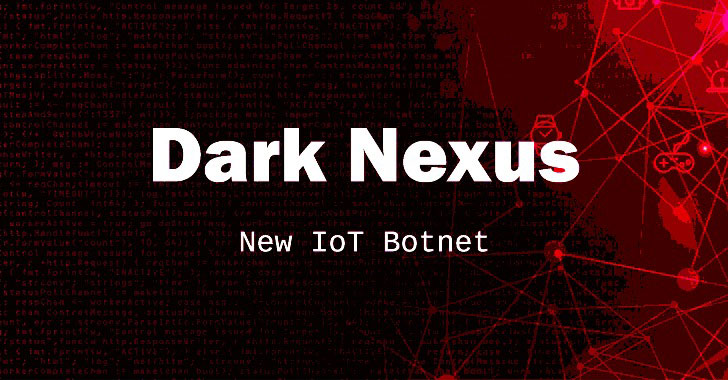Cybersecurity researchers have discovered a new emerging IoT botnet threat that leverages compromised smart devices to stage ‘distributed denial-of-service’ attacks, potentially triggered on-demand through platforms offering DDoS-for-hire services.
The botnet, named “dark_nexus” by Bitdefender researchers, works by employing credential stuffing attacks against a variety of devices, such as routers (from Dasan Zhone, Dlink, and ASUS), video recorders, and thermal cameras, to co-opt them into the botnet.
So far, dark_nexus comprises at least 1,372 bots, acting as a reverse proxy, spanning across various locations in China, South Korea, Thailand, Brazil, and Russia.
“While it might share some features with previously known IoT botnets, the way some of its modules have been developed makes it significantly more potent and robust,” the researchers said. “For example, payloads are compiled for 12 different CPU architectures and dynamically delivered based on the victim’s configuration.”
Evidence gathered by Bitdefender points to greek.Helios as the individual behind the development of dark_nexus, who is a known botnet author infamous for selling DDoS services on social media platforms and using a YouTube channel to advertise its capabilities.
Inspired by known botnets Qbot and Mirai
Noting dark_nexus’ similarities to Qbot banking malware and Mirai, Bitdefender researchers said its core modules are “mostly original” and that it’s frequently updated, with over 30 versions released during the period from December 2019 to March 2020 (versions 4.0 through 8.6).

“The startup code of the bot resembles that of Qbot: it forks several times, blocks several signals, and detaches itself from the terminal,” the researchers said.
“Then, in the vein of Mirai, it binds to a fixed port (7630), ensuring that a single instance of this bot can run on the device. The bot attempts to disguise itself by changing its name to ‘/bin/busybox.’ Another feature borrowed from Mirai is the disabling of the watchdog by periodic ioctl calls on the virtual device.”
The infrastructure consists of several command-and-control (C2) servers (switchnets[.]net:30047 amd thiccnigga[.]me:30047), which issue remote commands to the infected bots, and reporting servers to which bots share details about vulnerable services (e.g., devices protected by default passwords).
Once the brute-force attack succeeds, the bot registers to the C2 server identifying the device’s CPU architecture so as to transmit custom infection payload via Telnet, download bot binaries, and other malware components from a hosting server (switchnets[.]net:80), and execute them.
In addition, some versions of the botnet (4.0 to 5.3) come with a reverse proxy feature that lets the victim act as a proxy for the hosting server, thereby directing the infected device to download and store the necessary executables locally instead of having to connect to the central hosting server.
That’s not all. dark_nexus comes with persistence commands that prevent the device from getting rebooted by stopping the cron service and removing privileges to services that could be used to reboot said device in question.

“It also uses a technique meant to ensure ‘supremacy’ on the compromised device,” Bitdefender observed.
“Uniquely, dark_nexus uses a scoring system based on weights and thresholds to assessing which processes might pose a risk. This involves maintaining a list of whitelisted processes and their PIDs, and killing every other process that crosses a threshold (greater or equal to 100) of suspicion.”
Your IoT Devices Are Up for Hire
The Mirai botnet, since its discovery in 2016, has been linked to a number of large-scale DDoS attacks. Since then, numerous variants of Mirai have sprung up, in part due to the availability of its source code on the Internet.
Botnet authors, likewise, have staged brute-force attacks on WordPress sites to insert Qbot banking trojan and download additional malware.
The fact that dark_nexus is built on the foundations of Mirai and Qbot is proof of the evolving tactics of botnet operators and inexperienced hackers alike, allowing them to add new functionality by exploiting a variety of vulnerabilities in poorly secured IoT devices and amass modern botnet armies.
“Using YouTube videos demoing some of his past work and posting offerings on various cybercriminal forums, greek.Helios seems to have experience with IoT malware skills, honing them to the point of developing the new dark_nexus botnet,” Bitdefender researchers concluded.
Source: thehackernews.com


